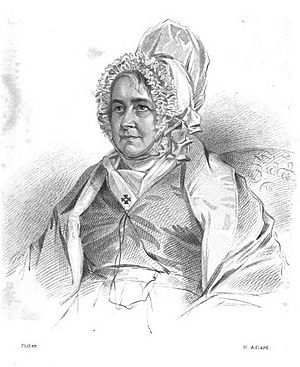Mary Anne Schimmelpenninck facts for kids
Mary Anne Schimmelpenninck (born Galton, 25 November 1778 – 29 August 1856) was a British writer. She was an important voice in the movement to end slavery in the United Kingdom.
Growing Up Years
Mary Anne was born in Birmingham in 1778. She was the oldest child of Samuel "John" Galton and Lucy Barclay. Her parents were members of the Society of Friends, also known as Quakers. They raised their children with strict rules.
In 1785, her family moved to Barr, Staffordshire. Many famous people visited their home there. These visitors included inventors like James Watt and thinkers like Joseph Priestley.
As a young woman, Mary Anne visited her cousins, the Gurneys. She also stayed with the writer Anna Barbauld. In 1806, Mary Anne Galton married Lambert Schimmelpenninck. His family was from the Netherlands and worked in shipping. The couple settled in Bristol. Mary Anne became involved in local charities and education. She even taught classes for young people at her home.
Becoming a Writer
Mary Anne Schimmelpenninck started writing to earn money. She was inspired by writings from a group called the Port-Royalists.
In 1813, she published her first book. It was called Narrative of a Tour to La Grande Chartreuse and Alet. This book was based on one of the Port-Royalist writings. It became very popular, and new editions were printed.
She continued to study the Port-Royalists' work. In 1815, she visited Port Royal during a trip to Europe. In 1816, she published a longer work about them. It was titled Narrative of the Demolition of the Monastery of Port Royal des Champs. Later, these two books were combined and republished as Select Memoirs of Port Royal.
Mary Anne also wrote about other topics. In 1815, she published Theory on the Classification of Beauty and Deformity. She also studied Phrenology, which was a way of studying the shape of the skull to understand a person's character. She created a system for recording findings during phrenology exams. This was published in 1827 as Phrenographic Register.
She also studied Hebrew and wrote Biblical Fragments in 1821–1822.
Her Beliefs
Mary Anne Schimmelpenninck explored different religious beliefs throughout her life. Even as a child, she had questions about her Quaker faith.
In 1818, she joined the Moravian Church. This is a Protestant Christian denomination. She remained a Moravian until she died. Towards the end of her life, she was interested in the Roman Catholic church, but she stayed with the Moravians.
Later Years
In 1837, Mary Anne Schimmelpenninck became ill with paralysis. She moved to Clifton to recover. Her health slowly got better.
After her husband passed away in June 1840, she lived a quiet life. She died in Bristol on 29 August 1856. She was buried in the Moravian chapel's graveyard there.
Other Works
Here are some other books written by Mary Anne Schimmelpenninck:
- Asaph, or the Herrnhutters; a rhythmical sketch of the modern history of the Moravians, 1822.
- Psalms according to the Authorised Version, 1825.
- Some Particulars relating to the late Emperor Alexander, translated from the French, 1830.
- The Principles of Beauty, as manifested in Nature, Art, and Human Character, edited by Christiana C. Hankin, 1859.
- Sacred Musings on the Manifestations of God to the Soul of Man, edited by Hankin, 1860.


